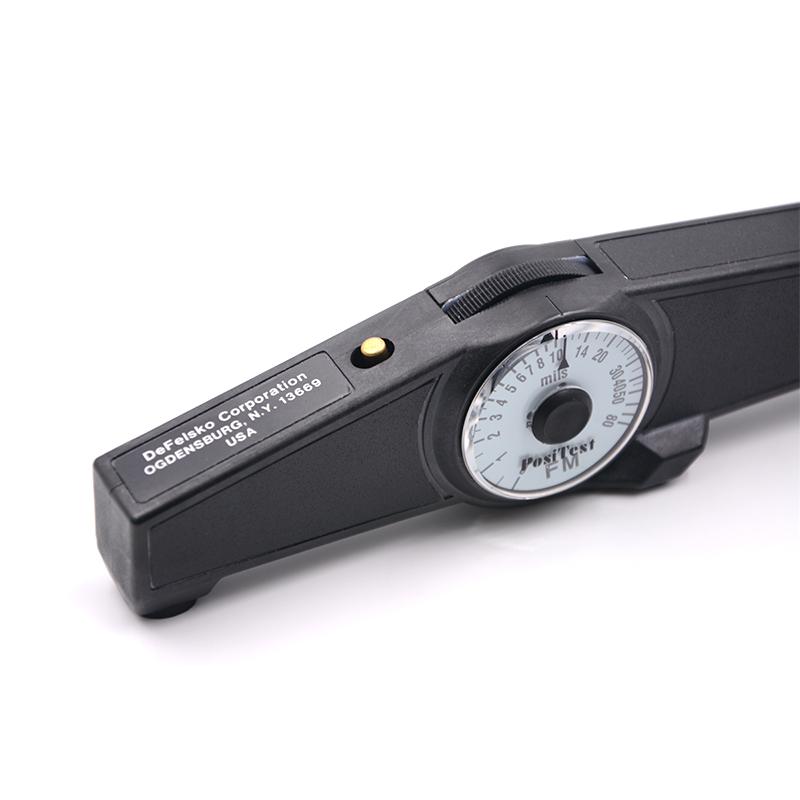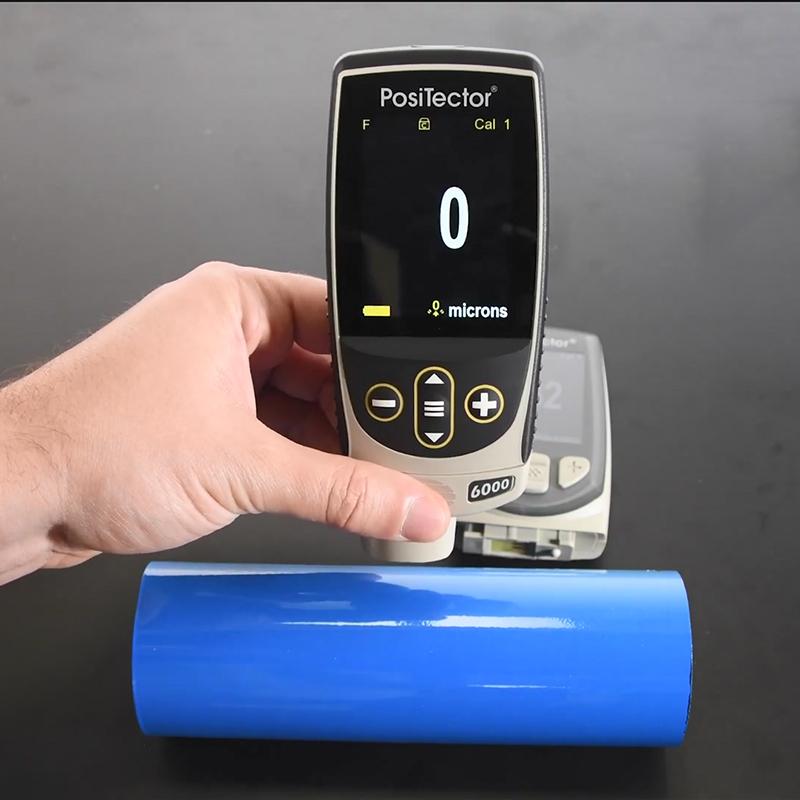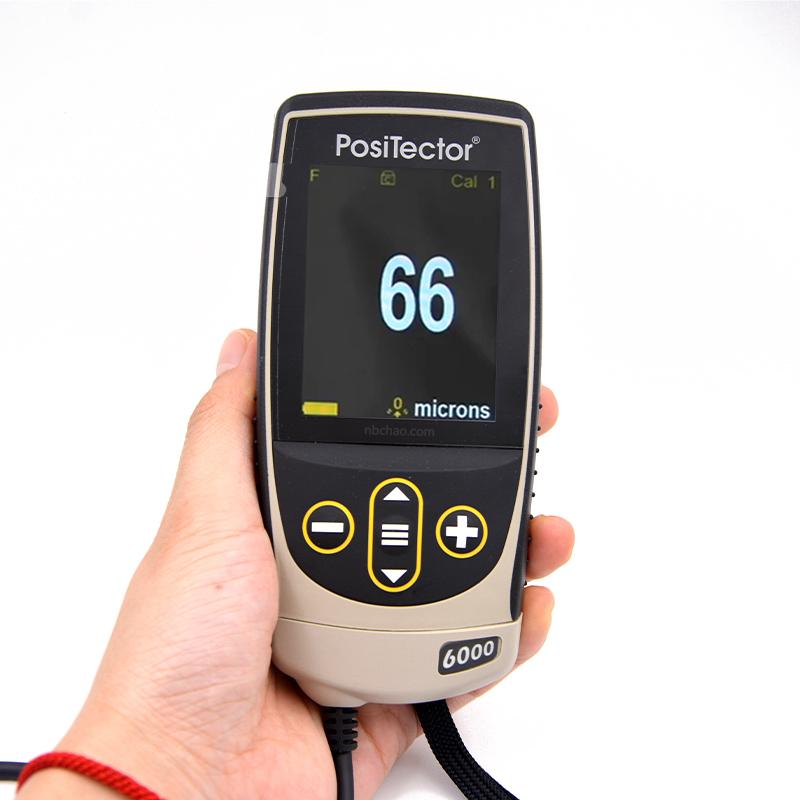การวัดความหนาของชั้นเคลือบแห้งแบบไม่ทำลาย
1. โดยปกติแล้วเครื่องมือแม่เหล็กจะใช้ในการวัดความหนาของการเคลือบแบบแห้งบนพื้นผิวเหล็ก. อุปกรณ์ปฏิบัติการที่ไม่ใช่แม่เหล็กสำหรับพื้นผิวโลหะที่ไม่ใช่เหล็ก. เครื่องมือวัดความหนาของชั้นเคลือบทั้งหมดจะต้องได้รับการสอบเทียบและวัดความหนาของชั้นเคลือบตามมาตรฐาน ASTM D1186 หรือ ASTM D1400.
2. การกำหนดความหนาของการเคลือบแต่ละชั้นในระบบเคลือบหลายชั้นควรเป็นจุดตรวจสอบ, โดยเฉพาะเมื่อชนิดของการเคลือบแต่ละชนิดแตกต่างกัน. ตัวอย่างเช่น, หากระบุระบบสีรองพื้นสังกะสีอนินทรีย์/อีพ็อกซี่อินเตอร์โค้ต/สีทับหน้าโพลียูรีเทน, ควรวัดแต่ละชั้นเพื่อให้แน่ใจว่ามีความหนาที่ถูกต้อง, เนื่องจากเครื่องวัดความหนาผิวเคลือบจะไม่บอกความหนาของชั้นเคลือบแต่ละชั้นบนชั้นเคลือบที่ทา. เมื่อตรวจวัดการเคลือบหลายชั้นด้วยเครื่องมือที่ไม่ทำลาย, ต้องกำหนดความหนาเฉลี่ยของชั้นแรกก่อนทาชั้นที่สอง. อย่างชัดเจน, the result measured after applying the second coat will be the total thickness of the two coats, and the specific thickness of the second coat can only be determined by subtracting the average thickness measured by the first coat.
การวัดความหนาของชั้นเคลือบแห้งแบบไม่ทำลาย
3. Where practical conditions permit, it is recommended that a method be provided to indicate that the coating thickness is too thin or too thick so that the coating builder can make appropriate repairs. Possible methods include brushing a light coating of the same color, a compatible brush marker, chalk, or other material that can be easily removed. Crayons or incompatible spray paint should not be used.
4. The coating thickness measurement is carried out to reasonably ensure that the specified thickness is achieved. อย่างไรก็ตาม, ไม่สามารถวัดทุกตารางนิ้วของพื้นผิวได้. ทั้ง ASTM D1186 และ D1400 ระบุว่าเมื่อใช้เครื่องมือวัดความหนาของสีเคลือบ, ควรทำการวัดห้าจุดแยกกันในแต่ละจุด 9.3 ตารางเมตร (100 ตารางฟุต) พื้นที่. การวัดแต่ละจุดประกอบด้วยค่าเฉลี่ยของการอ่านค่าเครื่องมือ 3 ครั้งใน 12.7 มม (1/2 นิ้ว) วงกลมเส้นผ่านศูนย์กลาง.
5. เครื่องมือวัดความหนาของฟิล์มแห้งแบบไม่ทำลายแบ่งออกเป็นสามประเภทพื้นฐาน: เครื่องวัดความตึงแม่เหล็ก, หัววัดแม่เหล็กไฟฟ้าและหัววัดกระแสไหลวน. เครื่องมือวัดความหนาของฟิล์มแห้งแบบทำลายล้างได้รับการจัดการแยกกัน.
(1) เครื่องวัดแรงแม่เหล็ก
เทนซิโอมิเตอร์แม่เหล็กมักประกอบด้วยคันโยกที่ผ่านศูนย์กลางของหน้าปัดที่ยึดคอยล์สปริง. หน้าปัดอยู่ที่จุดศูนย์กลางของคันโยก. One end of the spring is connected to the lever and the other end is connected to the dial. One side of the lever contains a permanent magnet, while the other end contains a counterweight.
The spring tension overcomes the magnet’s attraction to the substrate and lifts the magnet off the coated surface. The spring tension is calibrated so that the point at which the magnet separates from the surface can be equivalent to the distance between the magnet and the surface. This distance is converted to mil (or micron). The thickness reading represents the gap between the magnet and the substrate. อย่างไรก็ตาม, this reading may be affected by voids, สนิม, embedded impurities, สนิม, ฯลฯ. ดังนั้น, จำเป็นต้องมีการตรวจสอบด้วยภาพอย่างละเอียดในระหว่างกระบวนการทำงานเพื่อให้แน่ใจว่าการเคลือบถูกนำไปใช้กับพื้นผิวที่สะอาดและไม่มีการปนเปื้อนในระหว่างกระบวนการทำให้แห้ง.
การวัดความหนาของชั้นเคลือบแห้งแบบไม่ทำลาย
เกจวัดความหนาผิวเคลือบแรงแม่เหล็กต้องได้รับการปรับเทียบก่อน, ระหว่างและหลังการใช้งานแต่ละครั้งเพื่อให้แน่ใจว่าการวัดที่แม่นยำ. วิธีการสอบเทียบอธิบายไว้ใน ASTM D1186. ความหนาที่ทราบของปะเก็นพลาสติกจะถูกวางลงบนพื้นผิวขัดเงาโดยตรง จากนั้นจึงปรับเครื่องมือให้ใกล้เคียงกับความหนาของปะเก็นมากที่สุด. ควรเลือกปะเก็นหนึ่งหรือสองตัวที่แสดงถึงความหนาของการเคลือบสนามจริงเพื่อให้สามารถสอบเทียบได้ภายในช่วงการใช้งาน. ผู้ใช้ต้องจำไว้ว่าความแม่นยำของเครื่องวัดความตึงแม่เหล็กอยู่ระหว่าง 5% และ 10% ของการอ่าน, และการเบี่ยงเบนเล็กน้อยจากความหนาที่ระบุไม่ใช่เหตุผลในการปฏิเสธ.

การวัดความหนาของชั้นเคลือบแห้งแบบไม่ทำลาย
(2) หัววัดแม่เหล็กไฟฟ้า
เกจวัดความหนาของขาวัดแม่เหล็กไฟฟ้าสำหรับพื้นผิวเหล็กมีอธิบายไว้ใน ASTM D1186. เครื่องมือเหล่านี้ยังได้รับการสอบเทียบโดยใช้เครื่องมือที่ไม่ใช่แม่เหล็กอีกด้วย (พลาสติก) วิธีปะเก็นก่อนใช้งาน. เกจวัดความหนาผิวเคลือบส่วนใหญ่ที่ใช้ในอุตสาหกรรมควบคุมการกัดกร่อนจะเป็นประเภทนี้. พวกเขามีความแม่นยำ (±3% ถึง 5% การอ่าน, ขึ้นอยู่กับผู้ผลิต), ให้การแสดงผลแบบดิจิตอลของความหนา, และลดการตีความเครื่องชั่งแอนะล็อกของผู้ใช้. นอกจากนี้, เครื่องมือประเภทนี้มักจะติดตั้งไมโครโปรเซสเซอร์ที่เก็บข้อมูลการวัดและทำการประเมินทางสถิติของข้อมูลที่เก็บไว้, รวมถึงค่าเฉลี่ยด้วย, ส่วนเบี่ยงเบนมาตรฐาน, การอ่านสูงสุดและต่ำสุด, และผลการอ่านทั้งหมดที่ได้รับ. ข้อมูลนี้มักจะสามารถดาวน์โหลดลงในคอมพิวเตอร์และ/หรือเครื่องพิมพ์ได้ และสามารถประหยัดเวลาได้มากที่เกี่ยวข้องกับเอกสารการวัดด้วยตนเอง, การหาค่าเฉลี่ย, และกำหนดช่วงความหนา. อย่างไรก็ตาม, เพราะเครื่องมือเหล่านี้เป็นอุปกรณ์อิเล็กทรอนิกส์, พวกมันบอบบางและไวต่อความเสียหายในสนามมากกว่ามิเตอร์วัดความตึงเชิงกล. นอกจากนี้, เครื่องมือเหล่านี้มีความไวต่อพื้นผิวที่ขรุขระมากกว่า.

การวัดความหนาของชั้นเคลือบแห้งแบบไม่ทำลาย
Eddy current probe thickness gauges are described in ASTM D1400 for measuring the thickness of non-conductive coatings applied to non-ferrous metal substrates. The probe is excited by an alternating magnetic field within the metal and measured by modifying the electrical characteristics of the probe coil. The extent of these changes is determined by the distance of the probe from the substrate and is shown as the coating thickness on the thickness meter. The eddy current probe thickness gauge is calibrated using a plastic gasket on a non-ferrous metal substrate in a manner similar to an electromagnetic probe. Some instruments combine the electromagnetic probe and eddy current probe functions into a single unit.

(3) ข้อควรระวัง
Some precautions are required when using any instrument with magnets. The magnet is exposed, so it is easy to attract iron filings, steel pellets or particles. During use, the magnet must be cleaned, otherwise it will lead to incorrect readings. If the instrument is used on a soft coated film, a plastic gasket can be placed on top of the surface to prevent the magnet from deforming the coating. The distance from the edge of any surface to the instrument must not be less than 1 นิ้ว; The presence of residual magnetism in the structure of the measured coating can have a false effect on the reading. Dial type instruments (magnetic tensile thickness gauges) also present an additional problem of “human error” during use, as it is easy to continue turning the dial after the point at which the magnet is lifted from the surface, which will result in incorrect thickness measurements. ดังนั้น, it is necessary to ensure that the dial is stopped at the point where the magnet is unadsorbed from the surface.
6. The inspector shall record the date and location of the measurement, the type of coating tested (primer, intermediate coat, top coat), the product and the type of measuring instrument used, the calibration method and whether the inspection area conforms to the specifications.
